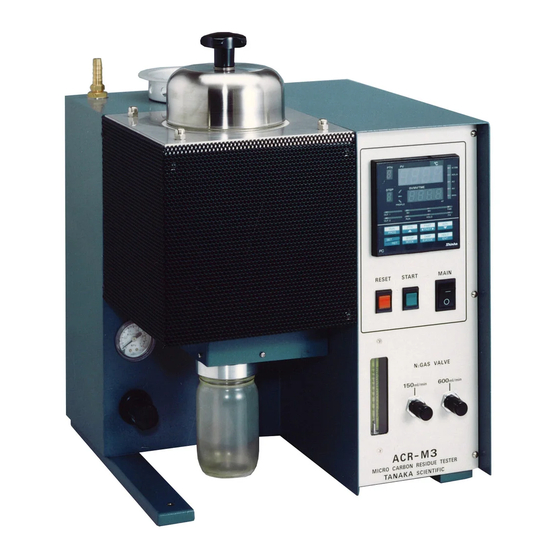
Table of Contents
Advertisement
Advertisement
Table of Contents

Summary of Contents for Tanaka ACR-M3
- Page 1 Micro Carbon Residue Tester Model ACR-M3 Instruction Manual Rev.2.10 100421 IMPORTANT: *This Manual contains important technical information as wall as safety information. *Read this Manual thoroughly before use, and keep it for later use. TANAKA SCIENTIFIC LIMITED...
-
Page 2: Table Of Contents
INTENDED READER OF THIS MANUAL …………………………………. 2 REVISIONS ……………………………………………………………...……... 2 SAFE OPERATION ……………………………………………………………. 2 WARNING ……………………………………………………………………..3 1. Overview of Model ACR-M3 ………………………………………………... 4 2. Installation ……………………………………………………………………. 6 2.1 Installation Site …………………………………………………...……….. 6 2.2 Electric Connections …………………………………………..…………... 6 2.3 Nitrogen Gas Connection …………………………….……….……….….. 6 2.4 Exhaust Connection …..…...……….……….……….……….……….……... -
Page 3: Intended Reader Of This Manual
・CAUTION : Indicates a potentially hazardous situation which, if not avoided, may result in minor or moderate bodily injury and/or property damages. And also the WARNING LABELS are put on the body of ACR-M3. The meaning of these labels is as follows. -
Page 4: Warning
Install the Tester in laboratory exhaust hood for safe venting of smoke and fumes. Alternatively, connect a vent line to the oven exhaust of ACR-M3. (If a vent line is used, do not connect directly to exhaust outlet to avoid creating negative pressure in the line.) -
Page 5: Overview Of Model Acr-M3
1. Overview of Model ACR-M3 Fig. 1 External View of Model ACR-M3 ① MAIN Switch: Used for turning the power ON/OFF. -
Page 6: Installation
Covers coking oven. The hot air passes though the opening. ⑭ Oven Cover (Lower): Covers exhaust piping. ⑮ Condensate Trap: Collects condensate. Can be unscrewed to remove from the ACR-M3. ⑯ Pressure Gauge: Indicates N gas pressure (secondly pressure). ⑰ Pressure Controller: Controls secondly pressure ⑱... -
Page 7: Electric Connections
Install the Tester on a level and steady table. Leave at least 20cm of spacing around the tester for sufficient air flow. The following locations should be avoided as the installation site: - An area with high temperature and/or high humidity - An area exposed to direct sun ray - An area with poor ventilation and/or dusty air - An area subject to rapid changes in ambient temperature... -
Page 8: Operation
The oven stop to heat? Flow meter points 150ml/min again? WARNING Should even a small abnormality is discovered, stop using the Tester and locate the problem. If the problem cannot be identified/resolved, inquire Tanaka or its authorized distributor. 4. Operation 4.1 Power ON... -
Page 9: Nitrogen Gas Pressure And Flow Rate Adjustment
Turn the MAIN switch ON. The electricity is supplied to the tester, then the cooling fan starts turning, and the current oven temperature is shown in the controller display. The solenoid valve for nitrogen gas opens. 4.2 Nitrogen Gas Pressure and Flow Rate Adjustment Adjust pressure controller for nitrogen gas until the nitrogen gas pressure gauge indicates 150kPa (0.15MPa: marked with green sign). - Page 10 600℃. Turn off the MAIN switch and resolve the trouble before starting your next test. Note 2 - ACR-M3 is preprogrammed to run carbon residue test. The detail of the program is described under the procedure of the ASTM D4530.
-
Page 11: Final Weighing
for saving gas. However, do not place a hot lid on the rest with the MAIN switch turned off. Setting Temperature ℃ Time(min) 39 44 47 600ml/min Flow Rate 150ml/min START Fig. 2 Temperature and Flow Program 4.5 Final Weighing Transfer sample vials to desiccator and allow vials to cool to room temperature. -
Page 12: Parts And Consumables
Tanaka. 5.1 Parts and Consumables When ordering parts and consumables for this Tester, put “Model ACR-M3” and Code# in front of the part name, since parts with similar description for different models exist. Also, attach the serial number information to the order. For more detail, contact Tanaka or its authorized distributor. -
Page 13: Inspection Procedure
gas leakage occurs at the seal. Also, in case coke builds up on the sealing surface of coking oven and/or lid, the seal gets leaky, resulting in gas leakage. It has been reported that the gas leakage alters the rate of sample evaporation, and as a result the test data may be affected. -
Page 14: Cleaning Oven Lip
(1) Remove the exhaust hose and condensate trap. (2) Lean the ACR-M3 to the right to sit it on its right side panel. (3) Scrub the deposit on the inside wall of exhaust port of oven using a file or stick. -
Page 15: Post-Sales Servicing
Manual. 9. Caution When Transferring This Tester If this Tester is transferred or sold to a third party, please inform Tanaka or its authorized distributor. Wrong source voltage and/or AC frequency could cause... -
Page 16: Specifications
damages or malfunctioning. In case of transferring this Tester, make sure to attach this Instruction Manual. 10. Specification (1) Conforming standard test methods: ISO 10370, ASTM D4530 (2) Coking Oven: with circular heating chamber, φ85mm by 105mm deep, made of stainless steel Heater: Pipe type, 500W ×2, made of stainless steel Heating Range: Up to 500℃... - Page 17 AC Power Code (AC100/120V: 3.0m, AC220/240V: 2.5m) Braided Hose for N Gas (3m) Wire Band for N Rubber Hose for Exhaust (5m) Hose Band for Exhaust Instruction Manual (12) Optional Accessories: Medium Vials (100/box): Test for ISO 10370 Holder for Mixed Vials (small/medium×6 and Large×3) Auxiliary Cooling Fan Unit: To help cooling the oven quickly Stage Regulator for nitrogen gas bomb : model WR-11-NP Primary Pressure: 15000kPa max.

Need help?
Do you have a question about the ACR-M3 and is the answer not in the manual?
Questions and answers